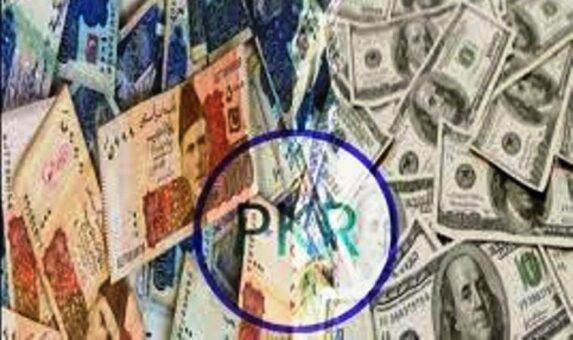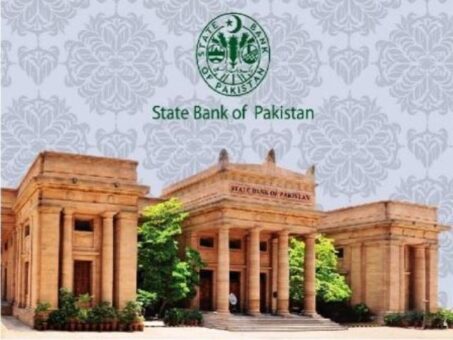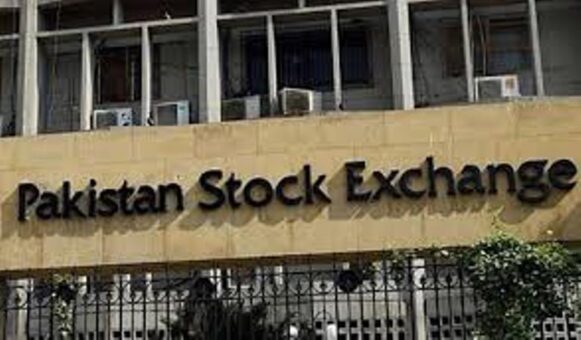KARACHI: The Pakistan Stock Exchange (PSX) faced a severe downturn on Thursday, with the benchmark KSE-100 index plummeting by 2,135 points in response to unfavorable reports on the fiscal front.
(more…)Author: Faisal Shahnawaz
-

Dollar makes new record high of Rs176.42 to Pak Rupee
KARACHI: The US dollar on Thursday recorded a record high of Rs176.42 against Pak Rupee (PKR) at the closing of the Interbank Foreign Exchange Market.
The rupee lost 94 paisas against the dollar from the previous day’s closing of Rs175.48 in the interbank foreign exchange market.
Previously, the rupee recorded an all-time low of Rs176.20 on November 29, 2021.
Currency experts said that higher imports and widening of trade deficit were the major reasons behind rupee deterioration.
During the first five months of the current fiscal year, exports and imports reached $12.4 billion and $33.1 billion, respectively. The trade deficit jumped up by 117 per cent YoY during the first five months of the current fiscal year to $20.8 billion.
The market was anticipating a recovery in the local unit after tightening of monetary policy stance by the State Bank of Pakistan (SBP) and signing for a Saudi support package for Pakistan. However, all these positive outcomes have failed to support the local currency.
-

Domestic oil sales surge by 18% in 5MFY22
KARACHI: The domestic oil sales have surged by 18 per cent to 9.6 million tons during first five months (July – November) of fiscal year 2021-2022 – 5MFY22 as compared with 8.16 million tons in the corresponding months of the last fiscal year.
Analysts at Arif Habib Limited said that double digit growth was witnessed in all categories; motor spirit, high speed diesel and furnace oil with off take undergoing a jump to 3.81 million tons, 3.74 million tons and 1.78 million tons (amid higher requirement from furnace oil based power plants), up by 11 per cent, 20 per cent and 29 per cent year on year (YoY) against 3.44 million tons, 3.12 million tons and 1.38 million tons in the same period of the last fiscal year, respectively.
Total petroleum and lubricant sales clocked-in at 1.75 million tons in November 2021, depicting an increase of 2 per cent YoY while down 12 per cent Month on Month (MoM) on account of significant decline in furnace oil volumes which clocked in at 0.18 million tons, down by 46 per cent MoM compared to 0.33 million tons in October 2021.
The decline in sales volumes has been attributed to power requirement in winter season which is usually lower compared to summer resulting in slowdown in dispatches and increase in prices of motor spirit (petrol) and high speed diesel.
On yearly basis, sales volumes witnessed a meager growth of two per cent YoY which was mainly led by sales growth in furnace oil and high speed diesel by three per cent and one per cent YoY, respectively.
-

SBP issues KIBOR rates on December 01, 2021
KARACHI: State Bank of Pakistan (SBP) on Wednesday issued the Karachi Interbank Offered Rates (KIBOR) as of December 01, 2021.
Following are the latest KIBOR rates:
Tenor BID OFFER 1 – Week 8.83 9.33 2 – Week 8.89 9.39 1 – Month 9.02 9.52 3 – Month 9.73 9.98 6 – Month 10.05 10.30 9 – Month 10.46 10.96 1 – Year 10.69 11.19 Source: State Bank of Pakistan -

Dollar eases to Rs175.48 at interbank closing
The Pakistani Rupee (PKR) strengthened against the US Dollar for the second consecutive day in the interbank foreign exchange market on Wednesday, closing at Rs175.48 per US Dollar, a recovery of 24 paisas from the previous day’s rate of Rs175.72.
(more…) -

SBP customers’ exchange rates on December 01, 2021
Karachi, Pakistan – The State Bank of Pakistan (SBP) has published the exchange rates for December 01, 2021, providing a comprehensive overview based on the weighted average rates of commercial banks.
(more…) -

SBP approves Saudi Bank for Samba Bank due diligence
KARACHI: The State Bank of Pakistan (SBP) has granted approval to Saudi National Bank (SNB) to undertake due diligence of Samba Bank Limited, according to information received on Tuesday.
Samba Bank Limited shared a communication with the Pakistan Stock Exchange (PSX) that the SBP had granted approval to SNB and its advisor, due diligence team, to undertake the due diligence of Samba Bank Limited with applicable laws, rules and regulations.
Samba Bank previously on September 21, 2021 communicated to the PSX that SNB, as the immediate parent company of Samba Bank Limited had notified: “SNB is considering all its strategic options in relations to its shareholding in Samba Pakistan Limited, including potential mergers, acquisitions, divestment and/or restructuring (the strategic review).
“Any decision relating to the strategic review shall be subject to internal approvals and may be subject to regulatory approvals as well as execution of the definitive agreement.”
It may be mentioned that SNB is the successor entity of Samba Financial Group, pursuant to a merger process in the Kingdom of Saudi Arabia, and regulatory formalities for the formal recording of Saudi National Bank as the successor entity in Pakistan is under process.
Samba Bank through a letter on October 05, 2021 made further disclosure to the stock exchange that the board of directors of SNB had approved the following actions in respect of Samba Bank Limited:
— To commence and orderly well managed divestment of Samba Bank Limited – Pakistan.
— To appoint an advisor to assist with the process, which has been done by SNB;
— to advise Samba Bank Limited on engagement with the regulators in Pakistan for the process, as necessary;
— To revert to the Board of Directors of SNB, before commencing a process of due diligence based on the receipt of Non-Binding offers and feedback from the market in the evaluation of this option.
-

SBP customers’ exchange rates on November 30, 2021
KARACHI, November 30, 2021 – The State Bank of Pakistan (SBP) has released the official exchange rates for November 30, 2021, providing customers and businesses with crucial information on currency values.
(more…) -

Rupee recovers against dollar on Saudi support deal
KARACHI: The Pak Rupee (PKR) recovers 48 against the dollar on Tuesday after positive sentiments prevailing in the market over the signing of the Saudi packages for Pakistan.
The rupee ended Rs175.72 to the dollar from the previous day’s closing of Rs176.20 in the interbank foreign exchange market.
A day earlier, the State Bank of Pakistan (SBP) and Saudi Fund for Development (SFD) signed a deposit agreement. Under the deposit agreement, the SFD would place a deposit of $3 billion with the SBP. The deposit amount under the agreement would become part of SBP’s foreign exchange reserves.
The rupee hit an all-time low of Rs176.20 on November 29, 2021.
Currency experts said that the market had witnessed high dollar demand for import and corporate payments. However, the reports of the Saudi support package helped the rupee to make some recovery.
In order to support the local currency, the SBP on November 19, 2021, decided to tighten the monetary policy stance. The SBP enhanced the key policy rate by 150 basis points to 8.75 per cent.
Although, the rupee recovered some value following the policy decision but the dollar demand persist for external payment and rupee plunged to the historic low.
-

SBP issues clarification on monetary policy decision
KARACHI: The State Bank of Pakistan (SBP) on Monday issued a clarification on media reports regarding the monetary policy decisions.
The SBP said that over the past few weeks, certain sections of the media including op-eds have expressed concerns over the actions of the SBP, particularly with regard to monetary policy decisions and the role of the Covid-related monetary accommodation in fueling the currently elevated inflation outturns.
The SBP would like to address these concerns and offer some clarifications.
First, while referencing the status quo monetary policy decisions in the earlier half of 2021, certain op-ed have implied that the central bank had absolved itself of its responsibility to combat inflation when it was rising.
Such points are all easier made in hindsight but let us remind ourselves what the situation was actually like back in May and July 2021. Demand-side pressures appeared contained with spare capacity in the economy, price pressures were concentrated in a few items, wage growth was subdued and inflation expectations were reasonably anchored.
Moreover, any inflationary concerns were dwarfed by the fact that Pakistan was going through the 3rd and subsequently the more virulent and uncertain 4th Delta-variant wave of Covid-19. There were a few occasions when micro lockdowns were imposed, while the vaccine rollout was not as extensive as it is currently.
Globally as well, Covid cases were spiraling upwards, driven primarily by the Delta variant. At such a time of elevated uncertainty about the future trajectory of the pandemic, the Monetary Policy Committee adopted a prudent policy stance by keeping interest rates unchanged, so as to not preemptively disrupt economic activity.
It is quite easy, in hindsight, to criticize this decision even though no tangible alternatives were proposed in the op-eds or elsewhere at the time.
By contrast, policymaking involves taking calculated decisions in real-time, when the future is uncertain and considerations need to be carefully balanced. This is especially so in the face of a shock like Covid, for which policymakers have no rulebook.
Second, in the midst of a once-in-a-century pandemic, it would be imprudent to solely superimpose classical economic theories onto data outturns.
Policymakers, economists and businesses around the world did not know how the global or domestic economy would evolve in response to mobility restrictions of varying stringencies in different locations.
Similarly, there was, and in fact continues to be, heightened uncertainty regarding price-setting behavior. For instance, there is an on-going debate in global policy circles and financial markets over whether the ongoing bout of inflation is transitory in nature or not. In the face of an unprecedented shock like Covid, invoking supposed historical, text-book patterns of overheating, as in the op-ed, is facile.
Under such circumstances, as policymakers around the world acknowledged, the costs of normalizing policies too soon outweigh those of waiting for more clarity on the path of inflation and output.
As that uncertainty has recently waned in Pakistan, monetary policy is being appropriately normalized.
Third, some commentary has seemingly attributed the currently higher inflation to the growth in broad money supply.
In this regard, the SBP would like to point out that at the start of the pandemic in March 2020 and for the subsequent few months, real broad money balances were in fact below the pre-Covid trend. If allowed to continue, a liquidity crisis would have turned into a solvency one, multiplying the contractionary impact of Covid-19 on real GDP growth.
To stave off this stark outcome, and to extend the needed support to businesses and households, the SBP and the government introduced unprecedented stimulative policy measures.
As a consequence, real money balances recovered as intended. Not providing this support would have risked worsening and prolonging the loss in output and employment that accompanied the Covid shock.
Lastly, the SBP would like to reiterate that its policy stance is geared towards price stability, while playing its due role in contributing to economic growth and development.
Getting this balance right through the various stages following Covid has been the key goal of monetary policy, and helps explain the path of policy actions.
